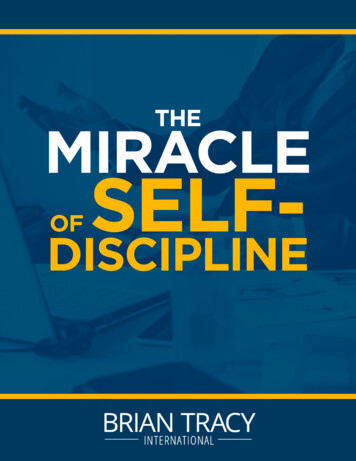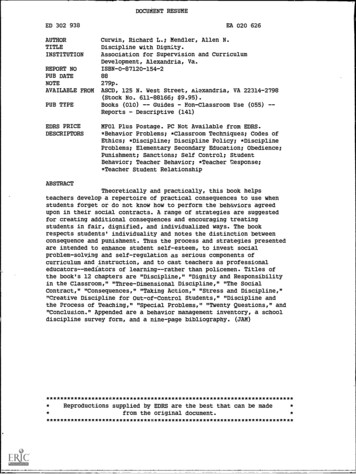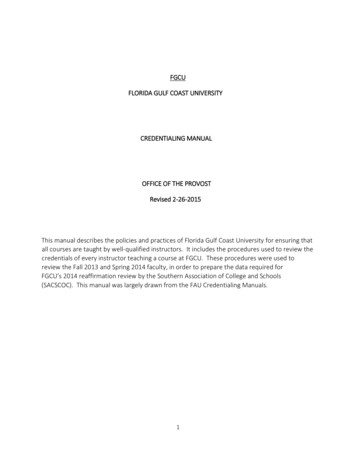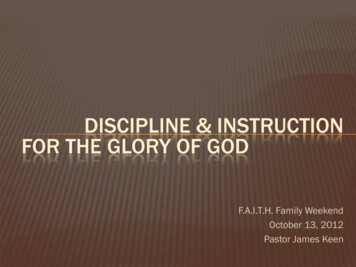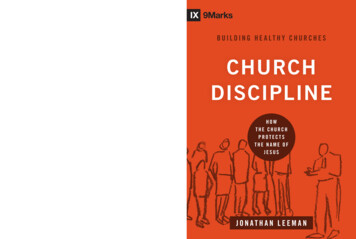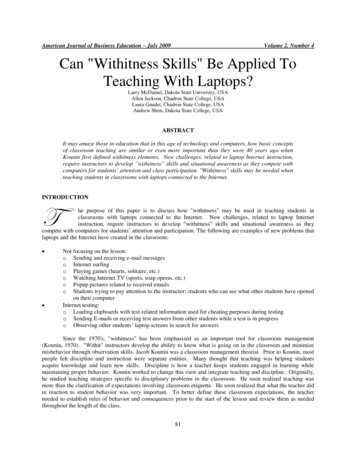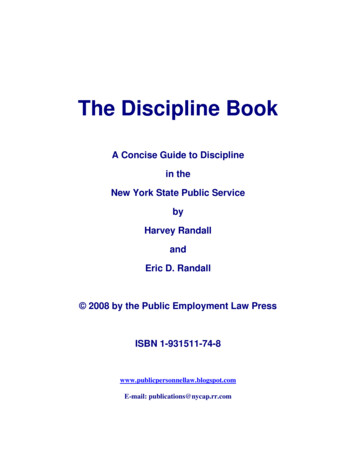
Transcription
The Discipline BookA Concise Guide to Disciplinein theNew York State Public ServicebyHarvey RandallandEric D. Randall 2008 by the Public Employment Law PressISBN mail: publications@nycap.rr.com
Readers please take note that:Consistent with the Declaration of Principles jointly adopted by a Committee ofthe American Bar Association and a Committee of Publishers and Associations,the material in The Discipline Book is presented with the understanding thatthe authors and the publishers are not providing legal advice to the reader andin the event legal or other expert assistance is needed, the reader should seeksuch advice from a competent professional.Also, the reader should be always aware of the fact that subsequent court andadministrative rulings, or changes to laws, rules and regulations may havemodified or clarified or vacated or reversed the material and the decisionssummarized here. Accordingly, these materials should be Shepardized orotherwise checked to make certain that the most recent information is beingconsidered by the reader.2
Table of ContentsINTRODUCTIONCHAPTER 1DUE PROCESS RIGHTS OF EMPLOYEESPart One: Who is entitled to due process?1.01 Due process rights depend on appointment status and jurisdictional classification1.02 Who is entitled to due process?1.03 Who has no due process rights?1.04 Due process rights under Section 3020-a1.05 The concept of tenure1.06 “Permanent” appointments, probation and tenure in the competitive class1.07 Permanent vs. probationer vs. provisional1.08 Probationers’ due process rights1.09 Temporary and provisional appointments1.10 Jurisdictional misclassification1.11 Budgetary classification irrelevant to due process rights of employees1.12 Rights of employees of quasi-government entities1.13 Veterans’ due process rightsPart Two: Forms of due process1.14 Impartial tribunals1.15 Specificity of charges1.16 Immunity from discipline3
1.17 Right to pre-determination hearing1.18 Ambiguity of language in Taylor Law agreements1.19 Right of appeal and timeliness1.20 Absence from hearings1.21 Notice of hearings1.22 Name-clearing hearings1.23 Due process and optional hearings1.24 Removal by operation of law1.25 Suspension without pay1.26 Authority to discipline1.27 Pending criminal matters1.28 Double jeopardy1.29 Civil rights1.30 First Amendment rights1.31 Freedom of information1.32 Public hearings1.33 Disciplinary action based on pre-employment misconductCHAPTER 2CONDUCTING AN INVESTIGATION2.01 Overview: Disciplinary investigations2.02 Handling complaints2.03 Anonymous allegations4
2.04 Fairness in investigations2.05 Interviewing employees2.06 Refusal to answer questions2.07 Free speech2.08 Self-incrimination and immunity2.09 Lying by employees2.10 Statute of limitations on discipline2.11 Legal representation during investigations2.12 Suspension with or without pay2.13 Affect of criminal actions on suspensions2.14 Impact of criminal action on disciplinary action, generally2.15 Voluntary resignations2.16 Issuing subpoenas, recording evidence2.17 Informants2.18 Evidence2.19 Recording investigation findings2.20 Record-keeping2.21 Defamation of employeesCHAPTER 3EVIDENCE3.01 Forms of evidence3.02 Hearsay evidence5
3.03 Standard of proof: criminal vs. disciplinary hearing3.04 Standard of proof, Section 753.05 Standard of proof, Section 3020-a3.06 Effect of criminal conviction or dismissal on discipline3.07 Testimony by the accused3.08 Best evidence rule3.09 Tainted evidence3.10 Confessions and coercion3.11 Competent and incompetent witnesses3.12 Opinion evidence3.13 Foundation for testimony3.14 Credibility of witnesses3.15 Conflicting evidence3.16 Employee surveillance3.17 Judicial notice3.18 Disclosure of personal records3.19 Unsealing criminal records3.20 Standard of conduct3.21 Admissions3.22 Source of documentary evidence3.23 Privileged communications3.24 Using polygraph tests in disciplinary actions3.25 Pitfalls for that a hearing officer must avoid6
CHAPTER 4PROPOSING A PENALTY4.01 The Pell standard4.02 Court review4.03 Lawful penalties4.04 Recommending penalties4.05 Using the individual’s employment history in disciplinary action4.06 Indemnification4.07 Expiration of the penalty4.08 Whistleblower protection4.09 Determining the penalty to be imposed4.10 Due Process and Progressive Discipline4.11 Substantial Evidence4.12 The Pell Standard of Fairness4.13 Reasons Courts Reject Penalties4.14 Violations of the Pell standard4.15. Penalty: reprimand4.16 Loss of leave credits and other alternative penalties4.17 Penalty: fine4.18 Penalty: suspension4.19 Penalty: demotion4.20 Time and attendance issues4.21 Examples of penalties imposed7
CHAPTER 5OBLIGATIONS OF EMPLOYERS AND UNIONSUNDER NEGOTIATED DISCIPLINARY PROCEDURES5.01 Notice of discipline5.02 The “Bill of Rights” in contracts5.03 Absence from work during disciplinary activities5.04 Duty of fair representation5.05 Procedures under contracts5.06 Reassignments5.07 Settlement5.08 Pre-hearing suspensionsCHAPTER 6FILING CHARGES UNDER Section 756.01 Key procedural elements6.02 Charges must be specific6.03 Employee must receive opportunity to respond6.04 Right to union representation6.05 Statute of limitations6.06 Serving charges6.07 Pitfalls to avoid6.08 Criticism is not discipline6.09 Admission of guilt difficult to retract8
6.10 Pending criminal charges6.11 Choice of lawCHAPTER 7FILING CHARGES UNDER Section 3020-a7.01 Statute of limitations7.02 Need for investigatory report regardless of merit of allegations7.03 Risk of libel or slander as a result of investigatory report7.04 Name-clearing hearings7.05 Pitfalls to avoid7.06 Criticism is not discipline7.07 Procedures in filing charges7.08 Use of school attorney7.09 Verdict shopping7.10 The Section 3020-a process7.11 Informing the Commissioner7.12 Hearing panel members7.13 Pre-hearing conferences7.14 Characteristics of arbitration9
CHAPTER 8SUSPENDING EMPLOYEES PENDING A HEARING8.01 Suspension without pay – general considerations8.02 Suspensions with pay, Sections 72 and 758.03 “Emergency” Suspensions8.04 Suspension without pay, generally8.05 Suspension without pay of unlicensed individual8.06 Suspension without pay in the event of postponement of disciplinary proceeding8.07 Suspension of a school superintendent8.08 Unpaid suspension past 30 days: Conflict with local law8.09 Suspension without pay, medical8.10 Suspension without pay8.11 Effect of criminal actions on suspensions8.12 Mitigation of damages8.13 Taxation of a settlement8.14 Recoupment of cash advances8.15 Bad faith8.16 Employment contracts8.17 Suspension with pay, pending criminal action8.18 Reassignment pending discipline8.19 Suspension without pay failure to report to work8.20 Repayment of salary after being continued on the payroll10
CHAPTER 9PENDING CRIMINAL ACTIONS9.01 Simultaneous prosecution9.02 Acquittal of criminal charges does not bar disciplinary action9.03 Criminal conviction bars administrative acquittal of the same charge9.04 Use of disclosures in criminal trials9.05 Probationers and criminal charges9.06 Reinstatement after acquittal9.07 Settlement to avoid prosecution9.08 Administrator’s immunity9.09 Collateral estoppel9.10 Disclosure of recordsCHAPTER 10PREPARING FOR A HEARING10.01 The settlement option10.02 Selecting a hearing officer10.03 Pre-hearing legwork10.04 A pre-hearing checklist10.05 Hearing in absentia10.06 Leave to attend hearing10.07 Mitigation of damages in cases of acquittal10.08 Taxation of a settlement11
10.09 Independent review of facts10.10 Considering material in a post-hearing brief submitted by a party10.11 Stay of arbitrationCHAPTER 11APPEALS11.01 Who may appeal?11.02 What may appeals concern?11.03 What standards apply in appeals?11.04 Forums for appeal11.05 Challenging a Section 75 decision11.06 Challenging an arbitration award11.07 Biased hearing officers11.08 Deadlines for appeal11.09 Timely and untimely appeals11.10 Outcomes of appeals11.11 Vacating or modifying penalties: The Pell Standard11.12 Back pay and benefits11.13 Statute of limitations11.14 Back salaryCHAPTER 12NON-DISCIPLINARY TERMINATIONS12
12.01 Termination for disability12.02 Section 73 pre-termination due process requirements12.03 Arbitrating Section 71 and Section 73 terminations12.04 Other provisions of law12.05 Considering disability claims12.06 Termination of a probationary employeeCHAPTER 13TERMINATIONS WITHOUT A HEARING13.01 Necessity of a license13.02 Removal by operation of law13.03 Disqualification for employment because of a criminal conviction13.04 Irrelevance of criminal history13.05 Removal after convictions13.06 Contract violation13.07 Denial of equal protection?13.08 Employees-at-will13.09 Withdrawing resignations13.10 Name-clearing hearings13.11 Noncompetitive class employees13.12 Disqualification, Section 50.4 CSL13.13 Nature of the offense13.14 Violation of oath of office13
13.15 Reversal of felony convictionCHAPTER 14REDRESS AND REMEDIES14.01 Delays in reinstatements14.02 Back pay14.03 ReinstatementCHAPTER 15DRUGS, DRUG TESTING AND DISCIPLINE15.01 Reasonable suspicion15.02 Pre-employment testing15.03 Due process guidelines15.04 Guidelines on employee privacy15.05 Observer’s presence during testing15.06 Drug testing and collective bargaining15.07 Penalties15.08 Refusal to participate in a drug treatment program15.09 Libel and slander15.10 The ADA and human rights laws14
CHAPTER 16SOME SPECIAL PROVISIONS OF LAWCHAPTER 17PROVISIONAL AND PROBATIONARY EMPLOYEES17.01 Tenure of provisionals by operation of law17.02 Tenure17.03 Reviewing probationary employee terminations17.04 “Permanent probationers”17.05 Standard of review17.06 Bad faith determinations17.07 Separation pay for probationary teachers17.08 Disciplinary probation17.09 Light duty and probationary requirements17.10 Drug use and probation17.11 Probation and alcoholism17.12 Probation and stress17.13 Extension of probation: modified duty17.14 Traineeships17.15 Extensions of the probationary period17.16 Attaining permanent status17.17 Date of permanent appointment and traineeships15
17.18 Non-competitive class employees17.19 Good faith determinations concerning probationary service17.20 Notice of termination17.21 Second probationary periods17.22 Good faith probationary decisions17.23 Name-clearing hearings17.24 Tenure by operation of law17.25 Transition from probationer to tenured17.26 Suspension of a probationer17.27 Rights under a Taylor Law agreement17.28 Distinguishing between temporary and provisional appointmentCHAPTER 18Case SummariesGeneral Index by Subject16
INTRODUCTIONThe Introduction to the First Edition of the Discipline Book sets out the philosophy and purposesunderlying the development and publication of this handbook. This edition updates the First Editionby incorporating significant court, administrative and arbitral rulings involving discipline, dueprocess and other important issues concerning the discipline process handed down since thepublication of the First Edition.1As the determination of the appropriate penalty to be imposed on an individual found guilty of oneor more charges is a critical consideration in satisfying administrative due process requirements, theSecond Edition incorporates selected portions of the Penalty Book, the companion volume to the1999 edition of the Discipline Book.Personnel administration in New York State in general may be viewed as poised on a three-leggedstool: one leg is the Civil Service Law and related personnel statutes; the second leg collectivebargaining pursuant to the Taylor Law; and the third leg – federal and state civil rights laws. Toneglect considering each of these elements when considering or processing a disciplinary action isto “court disaster.”As stated in the introduction to the First Edition, the discipline of employees is one of the mostcomplex and important areas of employer-employee relations in New York State publicemployment. To quote from the Introduction to the First Edition: This book explains the rulesgoverning discipline. Emphasis is placed on the importance of proper procedure, as defined by therelevant laws as well as court rulings and arbitration decisions made under those laws, mostnotably Section 75 of the New York State Civil Service Law [Section 75] and Section 3020-a[Section 3020-a] of the New York State Education Law. Also covered are disciplinary proceduresthat take place under alternatives to the statutory provisions that are authorized by collectivebargaining agreements negotiated under the New York State Taylor Law (Section 200 et sec of theCivil Service Law.)“Discipline is a legal process in which front-line decision-makers typically are not lawyers but laypeople -- police chiefs, agency administrators, school superintendents, et cetera. Likewise, unionofficials who represent employees in the disciplinary process may be assisted by counsel but arerarely lawyers themselves. This book is intended to aid such individuals by demystifying thedisciplinary process and cataloging some of the more salient legal issues that can arise in discipline.Also, attorneys who specialize in New York public employment law should find this book a usefulreference on both fundamental points and some of the finer nuances in the law of discipline.“The body of judicial precedent that pertains to discipline in New York State is substantial.Thousands of administrative disciplinary decisions and penalties have been challenged in lawsuitsfiled under Article 78 of the New York State Civil Practice Law and Rules (CPLR) or, where1N.B. Subsequent court and administrative rulings, or changes to laws, rules and regulations may have modified orclarified or obviated or vacated or reversed the material, the conclusions or the decisions summarized in this handbook.Accordingly, these material and summaries should be Shepardized or otherwise checked to make certain that the mostrecent information is being considered by the reader.17
arbitration is involved, pursuant to Article 75 of the CPLR. Fortunately for those who wish tounderstand the principles of discipline, the majority of these lawsuits concern similar questions andissues. Each chapter of this book addresses one of those common questions or issues. Chapter one,for instance, addresses the question: “Did the employee receive due process?” After an explanationof what due process is and why it is important, the chapter explains a number of types of dueprocess issues, usually with reference to a specific New York State or federal court decision thatdealt with that issue. Succeeding chapters are organized similarly.“The information provided in this book is intended to be neither pro-management nor pro-labor; itis the authors’ belief the public interest is served if all parties have a clear understanding of the law.For the disciplinary process to have integrity, the principles of fairness and sound proceduresshould be well-understood by all parties involved -- administrators responsible for personnelmanagement, the leaders of collective bargaining units and attorneys practicing public sector laborlaw in New York State.“Cases cited involve a variety of pubic employers including police agencies, school districts, statedepartments and agencies, and municipalities. Readers are cautioned against ignoring materialsimply because the type of public employer involved is different from the reader’s own. In manycases, identical principles apply regarding proper procedure. In the opinion of the authors, courtswill consider the decisions summarized in this handbook as precedents in future litigation involvingdisciplinary actions.“New York State Courts made most of the rulings cited in this book. As some readers may beunfamiliar with the hierarchy of the state court system, here is a summary: the first court withjurisdiction on many issues involving public employment in New York State is the New York StateSupreme Court. Decisions by any Supreme Court justice may be reviewed by the AppellateDivision of the New York State Supreme Court, usually referred to simply as the AppellateDivision. Decisions by the Appellate Division are reviewed by the Court of Appeals, which is NewYork’s highest court. Furthermore, federal courts may hear cases in which Constitutional issues areraised.“Of course, disciplinary procedures do not exist in a vacuum. Actions taken against an employeeunder a disciplinary procedure may be attacked as being discriminatory in violation of federal orState Human Rights Laws, or as being an unfair labor practice under the Taylor Law. TheAmericans with Disabilities Act of 1990 applies to public and quasi-public employers and is anadditional factor to be considered in disciplinary matters as well.“The reader should keep in mind that the law governing the disciplinary process is under constantrevision. No book can provide a definitive guide to what is lawful and what is not in a givensituation. This book is intended, rather, to acquaint readers with the general concepts ofadministrative due process so that they may make informed judgments in their roles. Readers areurged to seek early legal assistance when faced with an actual or potential disciplinary action.”Harvey Randall, J.D.Eric D. Randall, M.B.A.April 200818
CHAPTER 1DUE PROCESS RIGHTS OF EMPLOYEESPart One: Who is entitled to due process?When courts review the lawfulness of disciplinary actions taken against public employees, a singlequestion is the most fundamental: In the disciplinary process, did the employee involved receive allthe administrative due process to which he or she was entitled?Courts view the failure to satisfy any one of the elements required for administrative due process asa complete failure of the process and this will result in the complete frustration of the appointingauthority’s1 effort to discipline an officer or an employee.The vesting of the responsibilities of being an appointing authority is derived from local or statelegislation, or the charter of a locality. For example, the appointing authority for a Sheriff’sDepartment is typically the sheriff. In political subdivisions of the State the appointing authoritymay be the school board, the governing body of a public authority, a town board, the townsupervisor or the mayor. With respect to the State as an employer, the appointing authority isusually the agency or department head. In this book, the terms “appointing authority” and“employer” will be used interchangeably.When courts uncover an error in due process, they will void disciplinary penalties and eitherdismiss the case or remand (return) the case to the employer for reconsideration. Ignoring dueprocess is costly -- and unfair.Due process is short for “due process of law.” This is an old concept with roots in English commonlaw traditions. Under the common law, individuals could not be deprived of their liberty withoutdue process of law -- notice of the charges and a full and fair hearing before any action could betaken. Freedom from arbitrary action was deemed a form of liberty that must be protected. Overtime the concept of liberty was extended to cover property rights. Clearly, a farmer evicted from hisproperty without just cause was denied liberty. In the 16th century, the common law recognizedthat one’s job is a form of property and that keeping one’s job is a form of liberty. Under thecommon law, any person “put from his livelihood” had been denied liberty. Hence, no man couldbe denied his employment or trade without due process of law.In modern disciplinary actions, it is essential that employees’ due process rights be respected.Employees who are entitled to due process (typically, “permanent” and “tenured” employees)cannot be removed or subjected to any disciplinary penalty unless their incompetence ormisconduct has been proved by substantial evidence in a hearing. Like the criminal justice system,administrative disciplinary procedures incorporate fundamental due process concepts such as the19
presumption of innocence of the accused and the placing of the burden of proof on the chargingparty.Section 75 of New York’s Civil Service Law, for example, requires notice and hearing, the right torepresentation, the right to confront and present witnesses, and the right of review or appeal.Similar due process requirements are essential in alternative dispute resolution proceduresnegotiated through collective bargaining in accordance with the New York State Taylor Law.Contract disciplinary procedures typically cover only those employees who have rights understatutes such as Section 75 of the Civil Service Law or Section 3020-a of the Education Law.However, some collective bargaining agreements grant due process rights to certain groups ofemployees, such as provisional employees, who are not entitled to such rights by statute.This book concerns the discipline of public employees in New York State. Who is included in thepublic service in the state?In New York State, one may be employed in either the private sector or the public sector. Thepublic sector in New York has two components: the military service and the civil service. TheState’s military service is outlined in footnote2 below.The civil service consists of the classified service and the unclassified service. The “classifiedservice” comprises the bulk of “civil service employment” in New York State. Positions in theclassified service are under the jurisdiction of either the state Civil Service Commission or a localCivil Service Commission or Personnel Officer. Civil service positions that are not under suchjurisdiction are deemed to be in the “unclassified service,” which includes judges, elected officials,commissioners and teachers.Finally, the classified service is composed of four classes, known as jurisdictional classes: thecompetitive class, the noncompetitive class, the exempt class and the labor class. As explainedbelow, an individual’s statutory right to due process depends the nature of his or her appointmentby the State or a political subdivision of the State.1.01 Due process rights depend on appointment status and jurisdictional classificationThe right to due process is not universal. For example, a substitute teacher employed for a twoweek stint does not have the same right to due process as a tenured teacher. Likewise, a provisionalcivilian police dispatcher does not have the same right to due process as a detective holding apermanent appointment. It should be clear from these examples that the due process rights of an2Although this book essentially addresses discipline in the civil service of the State and its political subdivisions, NewYork also has a military service. New York’s military service has four components: the organized militia, the statereserve list, the state retired list and the unorganized militia. The organized militia consists of the New York ArmyNational Guard, the New York Air National Guard, the New York Naval Militia and the New York Guard. Theunorganized militia consists of “all able-bodied male residents between the ages of 17 and 45 who are not members ofthe organized militia or on the state reserve list or the state retired list.” The State’s Code of Military Justice, Article 7of the Military Law, sets out the disciplinary procedures to be followed with respect to members of the organizedmilitia, those on the State reserve list and those on the State retired list.20
individual employee flow from that individual’s appointment status and jurisdictionalclassification.Appointment status, also known as employment status, refers to whether one holds permanent,contingent permanent, temporary, or provisional appointment. The appointment status ofemployees in the public service is considered in “The Concept of Tenure” [See 1.05 below].The term jurisdictional classification3 refers to whether a position is (a) in the classified service,and therefore subject to the jurisdiction of a Civil Service Commission or (b) in the unclassifiedservice [Section 35, Civil Service Law], and therefore not subject to the jurisdiction of a CivilService Commission. “Jurisdictional classification” also refers to whether a given position in theclassified service is assigned to the competitive, non-competitive, exempt or labor class [Section2.10 of the Civil Service Law]. Unless placed in a different jurisdictional class by action of a civilservice commission or by statute, all classified service positions are in the competitive class.Issues of appointment status and jurisdictional classification are at the heart of a high percentage oflawsuits involving disciplinary cases. Anyone involved in the disciplinary process should look atthese issues first, because an employee’s due process rights depend on his or her actual, i.e.,statutory, appointment status and the actual jurisdictional classification of the position to which heor she has been appointed. We use the word “actual” because the failure of an employer to properlyidentify an employee’s statutory appointment status or the statutory jurisdictional classification ofthe individual’s position does not expand or diminish the employee’s legal rights.Probationers terminated during the probationary period often claim they were denied due processand constitute another significant body of individuals filing lawsuits against public employers inNew York State.For probationers, one other factor influences the right to due process beyond those listed above:how long the probationer has served in his or her position. Employees in competitive class or thenon-competitive class who are serving probationary periods have due process rights only if they (a)not yet completed the minimum period of probation, (b) have become “tenured” by successfullycompleting their probationary period, or (c) have become tenured by serving the maximum periodof probation and continuing to work in the position without having been removed by the appointingauthority. Being continued in service beyond the maximum period of service without theappointing authority having taken formal action to confirm or deny tenure in the position is referredto as attaining “tenure by estoppel” or sometimes as attaining “tenure by acquiescence”. In fact,Section 65.4 of the Civil Service Law actually provides for an appointee attaining tenure byestoppel under certain circumstances.In contrast, probationers may be dismissed without due process, i.e., notice and hearing, for anylawful reason or for no reason, if they have completed their minimum period of probation but have3The term jurisdictional classification is sometimes confused with “position classification.” Position classificationdeals with the duties and responsibilities of a position and, for State positions, its allocation to a salary grade. See 1.11below, “Budgetary classification is irrelevant to due process rights of employees.”21
not yet completed their maximum period of probation. See 1.05 below, “The concept of tenure,”and the successive sections.The categories of jurisdictional classification in the classified service are the competitive class,non-competitive class, exempt class and labor class. One might wonder why these different classesexist. The answer lies in Article V, Section 6 of the New York State Constitution, which requiresthat, wherever practicable, appointments and promotions in the civil service be made according tomerit and fitness. Competitive examinations are used to establish eligibility for such employment.Because competitive examinations are not practicable in every instance, the State Legislatureprovides guidelines for creating positions outside the competitive class. These positions may beplaced in one of three categories: the exempt class, the non-competitive class or the labor class.“Jurisdictional classification” refers to the decision-making process concerning whether a positionbelongs in the competitive class or one of the other classes listed above.In February 1998 the Civil Service Commission proposed a rule to clarify the categories outside thecompetitive class by establishing these definitions:Exempt class: “The exempt class is to include those positions specifically placed there by theLegislature, together with all subordinate positions for which there is no requirement that theperson appointed pass a civil service examination. Instead, appointments rest in the discretion ofthe person who, by law, has determined the position’s qualifications and whether the persons to beappointed possess those qualifications.”Non-competitive class: “The non-competitive class is to be comprised of those positions which arenot in the exempt or labor classes and for which the Civil Service Commission has found itimpracticable to determine an applicant’s merit and fitness through a competitive examination. Thequalifications of those candidates selected are to be determined by an examination which issufficient to insure (sic) selection of proper and competent employees.”The labor class: “The labor class is to be made up of unskilled laborers in the service of the Stateand its civil divisions, except those which can be examined for competitively.” [NYS Register, Feb.4, 1998, p.6]1.02 Who is entitled to due process?Broadly, the employees entitled to due process are those employees who are specifically granteddue process rights under a state statute such as Section 75 of the Civil Service Law or Section3020-a of the Education Law or a contract negotiated in accordance with the Taylor Law.Most Taylor Law agreements closely track, or incorporate by reference, either Section 75 orSection 3020-a regarding categories of employees entitled to due process. Those employees whoenjoy a statutory right to due process under Section 75 or Section 3020-a are:22
1. Tenured teachers in the public schools and BOCES. [Section 3020-a of the Education Law]; see1.04, “Due process rights under Section 3020-a,”
the material in The Discipline Book is presented with the understanding that the authors and the publishers are not providing legal advice to the reader and in the event legal or other expert assistance is needed, the read

